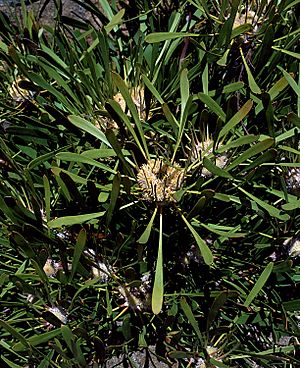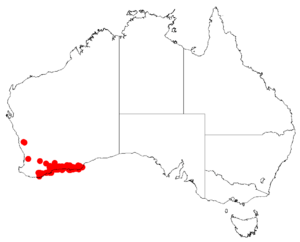Clustered coneflower facts for kids
Quick facts for kids Clustered coneflower |
|
|---|---|
 |
|
| Isopogon polycephalus in the ANBG | |
| Scientific classification | |
| Genus: |
Isopogon
|
| Species: |
polycephalus
|
 |
|
| Occurrence data from Australasian Virtual Herbarium | |
The Clustered Coneflower (scientific name: Isopogon polycephalus) is a special type of plant. It belongs to the Proteaceae family, which includes many unique Australian plants. This shrub grows only in a specific area: along the south coast of Western Australia. It's known for its spreading shape, long leaves, and beautiful clusters of white, cream, or yellow flowers that look a bit like spheres.
Contents
What it Looks Like
The Clustered Coneflower is a spreading shrub. It usually grows to about 1 meter (about 3 feet) tall. Its small branches are reddish-brown and covered in thick hairs.
Leaves and Flowers
The leaves of this plant are long and narrow. They are shaped like a line or a spear, with the narrowest part at the bottom. Each leaf is about 6 to 12 centimeters (2.4 to 4.7 inches) long. They are also about 6 to 10 millimeters (0.2 to 0.4 inches) wide. The end of each leaf has a hard, sharp point.
The flowers grow in round clusters. These clusters are often grouped together and are about 2.5 to 3 centimeters (1 to 1.2 inches) across. At the bottom of each flower cluster, there are special leaf-like parts called bracts. These bracts are long and narrow or shaped like a small egg. The individual flowers are about 1 to 1.5 centimeters (0.4 to 0.6 inches) long. They can be white, cream, or yellow. The flowers are also glabrous, which means they are smooth and hairless.
When it Blooms
The Clustered Coneflower blooms from August to January. After the flowers, the plant produces a hairy nut (a type of fruit). These nuts are joined together in a round head, which is about 2 centimeters (0.8 inches) wide.
How it Got its Name
The Clustered Coneflower was first officially described in 1810. A botanist named Robert Brown gave it its scientific name, Isopogon polycephalus. He wrote about it in a scientific paper.
Meaning of the Name
The second part of its scientific name, polycephalus, is from Greek words. "Poly" means "many," and "cephalus" means "headed." So, polycephalus means "many-headed." This name describes how the plant has many flower clusters or "heads."
Where it Grows
The Clustered Coneflower grows in sandy soil. You can find it in areas called heath or sandplain. These are open areas with low-growing plants. It grows between a place called East Mount Barren and Condingup. Both of these places are near the south coast of Western Australia.
Is it Endangered?
The Government of Western Australia's Department of Parks and Wildlife has looked at the Clustered Coneflower. They have classified it as "not threatened." This means that there are enough of these plants in the wild, and they are not currently at risk of disappearing.

